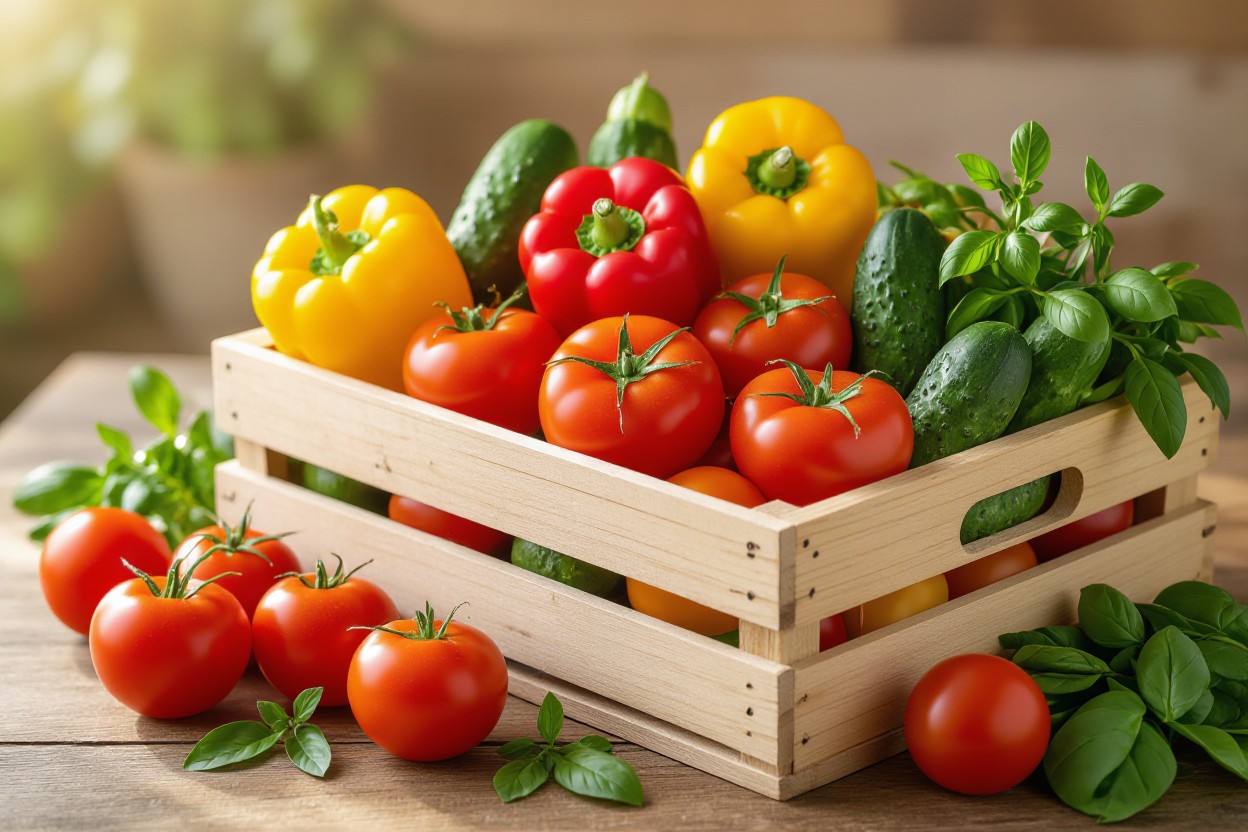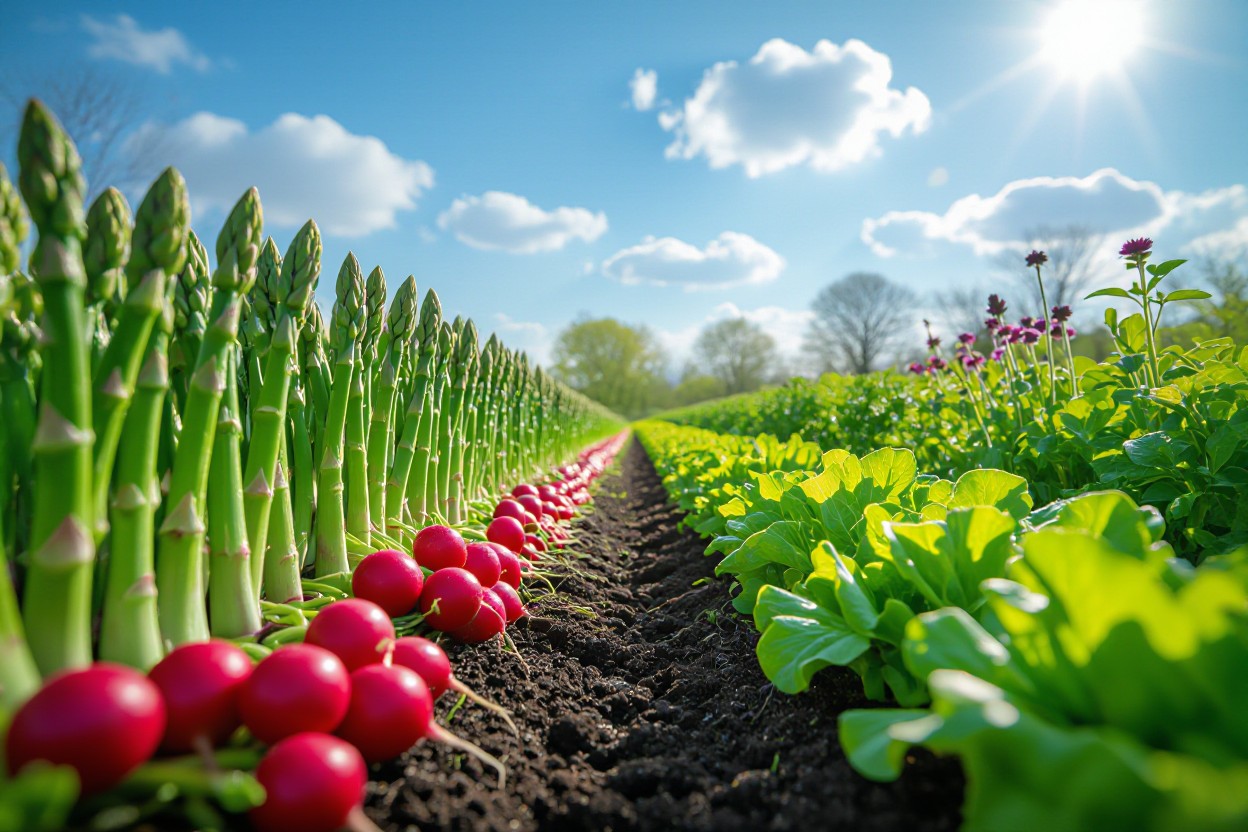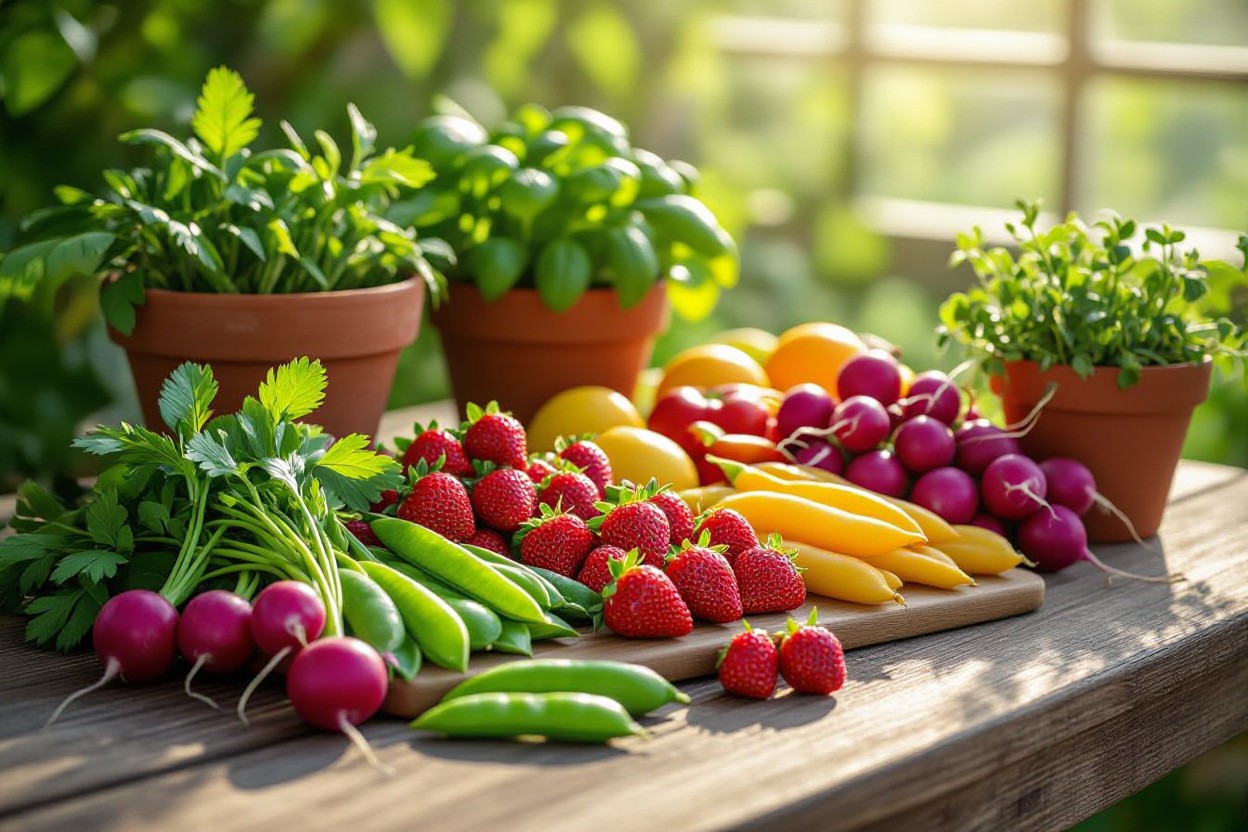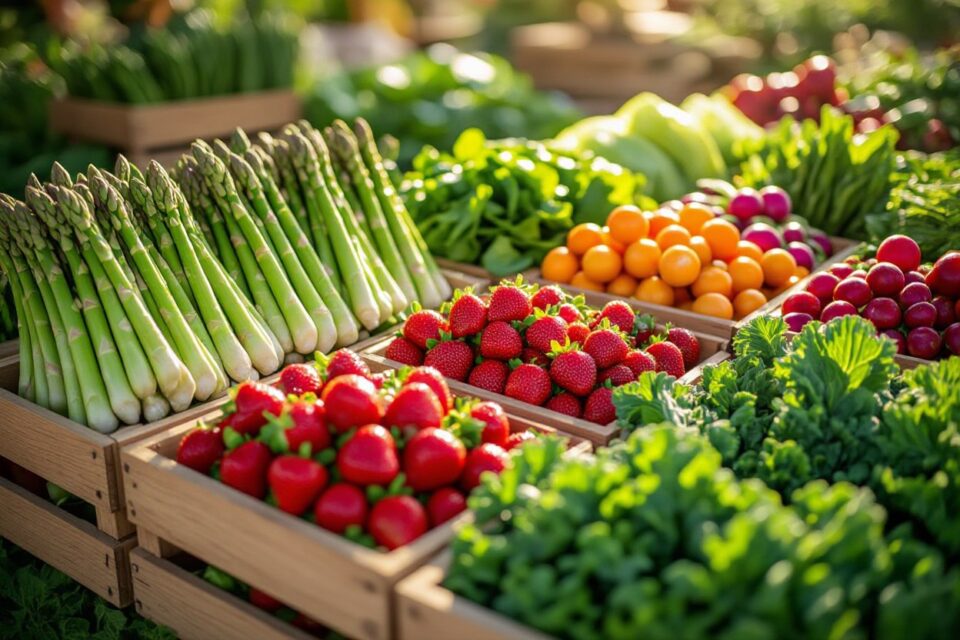Fresh flavors awaken your taste buds as spring blooms, and it’s the perfect time for you to refresh your diet with vibrant, seasonal produce. Incorporating nutrient-packed greens, juicy fruits, and crisp vegetables not only delights your palate but also boosts your energy and immunity. You’ll discover how these fresh foods support your well-being and add a burst of color to your meals. Get ready to explore simple, delicious options that will make you feel revitalized all season long!

The Flavorful Bounty of Spring Produce
Spring ushers in an exciting array of produce bursting with vibrant flavors and textures that can transform your meals. From tender asparagus tips to the crisp, sweet crunch of freshly harvested snap peas, these ingredients invite you to experiment with fresh salads, bright sides, and invigorating smoothies. By focusing on this season’s peak offerings, you can enjoy both nutritional benefits and tastes that truly celebrate spring’s renewal. The diversity available means you can find something new to try each week, keeping your menu fresh and satisfying.
Seasonal Stars: Top Fresh Fruits to Savor
Spring brings a luscious lineup of fruits like strawberries, apricots, and cherries, each offering a unique burst of sweetness and tang. Strawberries, rich in vitamin C and antioxidants, are especially versatile—perfect for breakfast bowls or refreshing salads. Apricots add a delicate tartness, while cherries provide a deep, satisfying flavor that pairs beautifully with cheeses or in desserts. Including these fruits in your diet not only enhances flavor but also boosts your intake of vital nutrients to keep you energized.
Leafy Greens: Nutrient Powerhouses for Spring Salads
Spring’s leafy greens—think baby spinach, arugula, and Swiss chard—pack an impressive punch of vitamins A, C, and K, plus crucial minerals like iron and calcium. Their fresh, slightly peppery or sweet flavors bring a delightful contrast to your spring dishes. You can toss these greens in a simple olive oil dressing, boost them with nuts and seeds, or blend them into green smoothies to maximize their health benefits while keeping your meals exciting.
Diving a bit deeper into leafy greens, baby spinach thrives in cooler spring weather and has a tender texture that’s fantastic for raw or lightly cooked dishes. Arugula’s distinct peppery bite adds character to salads, transforming even the simplest combinations into memorable bites. Swiss chard, with its vibrant stems and earthy leaves, offers versatility whether sautéed, added to soups, or used as a wrap alternative. Incorporating a variety of these greens ensures your spring plate stays nutrient-rich and full of flavor, helping you enjoy every bite of this season’s freshness.

Transformative Cooking Techniques for Seasonal Ingredients
Delving into spring’s vibrant produce, employing diverse cooking methods can completely transform their flavors and textures. Whether you opt for roasting, grilling, steaming, or quick sautéing, each technique pulls out different nuances and layers of taste. Experimenting with temperature and timing, you’ll uncover how simple vegetables like asparagus or radishes can become the star of your meal. Embracing these methods enhances not only the taste but also the nutritional value of your dishes.
From Raw to Roasted: Elevating Spring Vegetables
Roasting is an exceptional way to bring out the natural sweetness and deepen the complexity of spring vegetables such as fennel, carrots, and new potatoes. As you roast at 400°F for about 20-30 minutes, the edges caramelize, delivering a delightful contrast between tender interiors and crisp exteriors. Toss your veggies with olive oil, fresh thyme, and a pinch of sea salt for a simple but flavorful side that celebrates the season.
Fresh Herb Magic: Infusing Flavors in Every Bite
Add fresh herbs like tarragon, chives, and basil at the end of cooking or toss them raw into your dishes to instantly brighten flavors. These aromatic greens release their imperative oils when chopped finely, creating an overwhelming sensory experience. Using fresh herbs builds layers of depth, turning everyday meals into vibrant celebrations of spring’s bounty.
To truly harness the magic of fresh herbs, grow or source them just before use, ensuring maximum potency. Techniques like chiffonade slicing delicate basil or infusing oils with rosemary can intensify their aroma. Adding a handful of chopped parsley or mint to salads and dressings introduces refreshing notes that elevate even the simplest spring dishes, transforming them into memorable culinary experiences.

The Proven Health Benefits of Eating Seasonally
Choosing seasonal produce like spring asparagus, strawberries, and peas ensures you’re getting fruits and vegetables at their nutritional peak. These foods often have higher vitamin and antioxidant levels because they’re harvested fresh, not stored for long periods. Eating seasonally can also introduce you to a more varied diet, which supports gut health and boosts your immune system. Plus, it reduces exposure to pesticides and preservatives commonly used in out-of-season imports, making your meals cleaner and healthier.
Nutritional Perks: Why Spring Foods Are Better for You
Spring vegetables such as spinach and radishes contain concentrated nutrients, offering more vitamin C, folate, and fiber compared to off-season varieties. For example, spring spinach has about 30% more antioxidants than winter-harvested spinach. This surge in nutrients supports cellular repair and helps fight inflammation. Eating these fresh picks can elevate your energy levels and improve digestion, powering you through those longer, sunnier days with natural vitality.
Mindful Eating: Connecting with Nature on Your Plate
Eating seasonally invites you to attune your palate and plate to nature’s rhythms, making each meal a sensory experience. When you savor freshly picked spring peas or cherry tomatoes bursting with juice, you engage more fully with your food’s natural flavors and textures. This connection enhances satisfaction, reduces overeating, and cultivates gratitude for the environment’s role in your nourishment.
Diving deeper, mindful eating rooted in seasonality aligns your diet with local ecosystems and traditional agricultural cycles, fostering sustainability. As you explore farmer’s markets or gardens, noticing the vivid colors and fresh scents sharpens awareness and enjoyment of your food. Studies reveal that this practice can lower stress and improve digestion by promoting slower, more intentional eating habits. The seasonal shift nudges you to appreciate diverse foods and supports both your mental well-being and physical health.
Delicious Spring Recipes to Try Now
Spring offers an abundance of vibrant flavors that lend themselves perfectly to fresh, flavorful recipes. Whether you’re craving something light or packed with bold tastes, integrating fresh peas, asparagus, or rhubarb into your meals can transform your dining experience. Using these ingredients directly from farmers’ markets or your own garden lets you explore the season’s bounty in dishes like grilled asparagus with lemon zest or strawberry-rhubarb crisp. Mixing in fresh herbs like mint and basil further enlivens your palate, providing you with colorful, nutritious meals that celebrate spring’s essence.
Colorful Spring Salads: A Mix of Taste and Nutrition
Mixing crisp spring greens such as arugula with sweet snap peas, radishes, and pops of bright edible flowers creates a salad that’s both visually stunning and packed with vitamins A and C. Tossed with a zesty lemon vinaigrette and some toasted almonds, these salads provide a refreshing crunch while delivering antioxidants and fiber. You can add grilled chicken or fresh goat cheese for extra protein, making your salad as satisfying as it is nutrient-rich – a fantastic option for lunch or a light dinner.
Quick and Easy Spring Dishes for Everyday Cooking
Simple stir-fries and one-pan meals featuring fresh spring vegetables allow you to whip up meals in under 30 minutes, perfect for busy weeknights. Consider sautéing asparagus tips with garlic and cherry tomatoes, tossing one-pot pasta with peas and fresh herbs, or roasting a medley of carrots and new potatoes with a drizzle of olive oil and thyme. These recipes require minimal prep but maximize flavor, helping you embrace seasonal eating without spending hours in the kitchen.
For example, a quick asparagus and pea risotto can be ready in about 25 minutes, using fresh stock and Parmesan to bring out earthy sweetness. Stir-fries combine crunchy vegetables with lean proteins like shrimp or chicken, while one-pan roasted dishes allow for easy cleanup, ensuring your cooking process remains as fresh and enjoyable as the ingredients you’re using. These approachable recipes help you stay connected to the season’s best produce, promoting both convenience and wholesome eating.
Where to Find the Best Seasonal Ingredients
Your quest for the freshest spring ingredients can lead you to several excellent sources, each offering unique benefits. From quaint community hubs like farmers’ markets to well-curated grocery stores, you’ll discover how the season’s bounty shines brightest when you pick the right spot. Depending on your location and accessibility, these sources can provide everything from sweet strawberries at their peak to vibrant asparagus straight from the fields.
Local Farmers’ Markets: Embracing Community and Freshness
Farmers’ markets are goldmines for vibrant, freshly harvested spring produce, often picked within the last 24 hours. Besides connecting directly with growers, you get to explore heirloom varieties and less common finds like purple carrots or fiddlehead ferns. By shopping here, you support local agriculture and gain insights about produce handling and recipes from passionate farmers, enriching your culinary experience with freshness and community spirit.
Grocery Store Strategies: Picking the Best of Spring Produce
Grocery stores carry an impressive array of spring fruits and vegetables, but knowing what to look for ensures you bring home the best. Focus on seasonal sections prominently displayed near entrances or produce aisles. Look for glowing signs of ripeness like bright, unblemished strawberries or firm bundles of asparagus with tightly closed tips. Bulk items stored in well-ventilated displays usually indicate higher turnover and better freshness. Don’t overlook organic and local labels for added quality assurance.
Diving deeper into these strategies, you might notice that many stores receive multiple shipments weekly during spring, increasing the chances of fresh stock. Check the origins carefully; for example, California and Florida are prime producers of early spring berries and greens. If buying greens like spinach or kale, opt for crisp, vibrant leaves without yellowing edges or sogginess. Utilizing these insights at your grocery store turns an ordinary shopping trip into a seasonal harvest adventure, ensuring you always get the freshest and most flavorful ingredients for your spring cooking.
Final Words
Presently, embracing these fresh foods this spring can truly brighten your meals and boost your well-being. By including vibrant fruits and crisp veggies in your diet, you’ll enjoy not only delicious flavors but also a natural energy lift. Your body will thank you for the nutrients and antioxidants packed into these seasonal delights. So, why not explore new recipes and savor the freshness of spring’s bounty? You deserve to feel your best, and these foods are a wonderful way to nurture your health and happiness all season long.
FAQ
Q: What are some fresh foods that are in season during spring?
A: Spring offers a variety of fresh foods including asparagus, peas, radishes, rhubarb, strawberries, artichokes, and new potatoes. These foods are at their peak in flavor and nutrition during this time of year.
Q: How can I incorporate fresh spring vegetables into my meals?
A: Fresh spring vegetables can be used in salads, stir-fries, soups, or simply roasted as a side dish. For example, asparagus can be grilled, peas added to pasta, and radishes sliced into fresh salads for a crunchy texture.
Q: Are there any health benefits to eating seasonal spring foods?
A: Yes, seasonal spring foods are rich in vitamins, minerals, and antioxidants that support overall health. Eating seasonal produce ensures you get fresher, more nutrient-dense foods which can aid digestion, boost the immune system, and improve energy levels.
Q: What fruits are commonly available fresh in spring, and how should they be eaten?
A: Strawberries and rhubarb are popular fresh fruits in spring. Strawberries can be enjoyed raw, added to yogurt, cereals, or desserts. Rhubarb is often cooked into pies, jams, or compotes due to its tartness.
Q: How do fresh spring foods differ in taste compared to out-of-season produce?
A: Fresh spring foods tend to have a more vibrant and natural flavor because they are harvested at their optimum ripeness. Out-of-season produce may be picked early and transported long distances, which can affect taste and texture negatively.
Q: Can eating fresh foods in spring help with seasonal allergies?
A: While fresh foods themselves don’t cure allergies, consuming antioxidant-rich fruits and vegetables can support the immune system and help reduce inflammation, which may alleviate some allergy symptoms. Local honey and fresh herbs are sometimes believed to provide additional relief.
Q: How can I best store fresh spring produce to maintain its freshness?
A: Most spring vegetables and fruits should be stored in the refrigerator in perforated plastic bags or containers to maintain humidity. Some items like asparagus can be stored upright in water, while berries should be kept dry and consumed within a few days for best quality.
